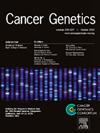20. FIP1L1::KIT fusion in a case of peripheral T-cell lymphoproliferative neoplasm responsive to tyrosine kinase inhibitor
IF 2.1
4区 医学
Q4 GENETICS & HEREDITY
引用次数: 0
Abstract
Myeloid/lymphoid neoplasms with eosinophilia and defining gene rearrangements commonly involve FIP1L1::PDGFRA. Eosinophilia is not an invariable feature. Neoplastic myeloid/lymphoid populations may be present at the same or different sites, with T-cell neoplasms being the conventional lymphoid component.
The case involves a 43-year-old male with chronic intractable disseminated skin rashes. Blood flow cytometry showed an aberrant T-cell population with no surface CD3 expression. Atypical T-cell infiltrates were present in the bone marrow, skin, and inguinal lymph node biopsy, and clonal TRG rearrangements were detected in blood, skin, and lymph node. However, there were no specific features to definitively classify the abnormal T-cell infiltrates. Bone marrow was fibrotic and hypercellular with only focal eosinophilia. Next-generation sequencing of blood and lymph node detected no significant mutations, and bone marrow cells demonstrated a normal karyotype. Fluorescence in situ hybridization demonstrated loss of both the CHIC2 and PDGFRA signals, with retention of the FIP1L1 signal. Whole-genome microarray analysis revealed an ∼1.3 Mb loss in the 4q12 region with breakpoints within the FIP1L1 and KIT genes. A novel FIP1L1::KIT fusion was confirmed by RNA-sequencing demonstrating in-frame retention of the KIT tyrosine kinase domain. The patient had a poor response to chemotherapy but superb response to the tyrosine kinase inhibitor, dasatinib.
FIP1L1::KIT fusion has not been described in systemic peripheral T-cell neoplasms without significant abnormality in myeloid lineage. This case indicates that KIT fusions are targetable genetic lesions and supports the inclusion of KIT fusions in the myeloid/lymphoid neoplasms with defining gene rearrangement.
20.对酪氨酸激酶抑制剂有反应的一例外周 T 细胞淋巴组织增生性肿瘤中的 FIP1L1::KIT 融合
嗜酸性粒细胞/淋巴细胞瘤伴有嗜酸性粒细胞增多和确定性基因重排,通常涉及 FIP1L1::PDGFRA。嗜酸性粒细胞增多并不是不变的特征。肿瘤性髓细胞/淋巴细胞群可能出现在相同或不同的部位,T 细胞肿瘤是传统的淋巴成分。本病例涉及一名 43 岁男性,患有慢性难治性播散性皮疹。血液流式细胞术显示T细胞群异常,表面无CD3表达。骨髓、皮肤和腹股沟淋巴结活检发现非典型T细胞浸润,血液、皮肤和淋巴结检测到克隆TRG重排。但是,没有明确的特征可以对异常的T细胞浸润进行分类。骨髓呈纤维化和高细胞性,仅有局灶性嗜酸性粒细胞增多。血液和淋巴结的下一代测序没有检测到明显的突变,骨髓细胞的核型正常。荧光原位杂交显示,CHIC2和PDGFRA信号消失,FIP1L1信号保留。全基因组芯片分析显示,4q12区域有1.3 Mb的缺失,断点位于FIP1L1和KIT基因内。RNA测序证实了一种新型的FIP1L1::KIT融合,显示了KIT酪氨酸激酶结构域的框内保留。该患者对化疗反应不佳,但对酪氨酸激酶抑制剂达沙替尼的反应极佳。FIP1L1::KIT融合在髓系无明显异常的全身性外周T细胞肿瘤中尚未见报道。本病例表明,KIT融合是可靶向的遗传病变,并支持将KIT融合纳入具有确定基因重排的髓/淋巴肿瘤中。
本文章由计算机程序翻译,如有差异,请以英文原文为准。
求助全文
约1分钟内获得全文
求助全文
来源期刊

Cancer Genetics
ONCOLOGY-GENETICS & HEREDITY
CiteScore
3.20
自引率
5.30%
发文量
167
审稿时长
27 days
期刊介绍:
The aim of Cancer Genetics is to publish high quality scientific papers on the cellular, genetic and molecular aspects of cancer, including cancer predisposition and clinical diagnostic applications. Specific areas of interest include descriptions of new chromosomal, molecular or epigenetic alterations in benign and malignant diseases; novel laboratory approaches for identification and characterization of chromosomal rearrangements or genomic alterations in cancer cells; correlation of genetic changes with pathology and clinical presentation; and the molecular genetics of cancer predisposition. To reach a basic science and clinical multidisciplinary audience, we welcome original full-length articles, reviews, meeting summaries, brief reports, and letters to the editor.
 求助内容:
求助内容: 应助结果提醒方式:
应助结果提醒方式:


